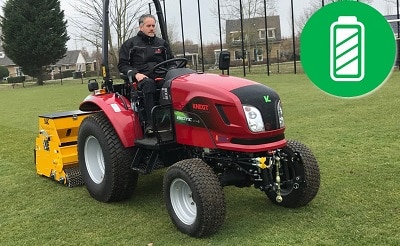Mowing Long Grass – The Challenges

The Challenges of Long Grass Mowing
Long grass mowing can be defined as cutting grass more than half of its length.
The general rule of thumb used within the industry is to never cut a frequently mown lawn (every two weeks or less) by more than one third of the height of the grass as this is detrimental to grass sward health and promote the ingress of weeds and moss.
The most common example would be if a user goes on holiday for two weeks in the summer and comes back and mows the lawn at the same height as before. The lawn will of course suffer stress and will take longer to recover. The operator should have a look at the grass and set the height of the rough grass mower so that when cut no more than a third of the lawn canopy is removed. Example – If the lawn has grown to 3 inches in two weeks and the lawn mower is set at 1.5inches the operator needs to raise the height of cut to 2inches to ensure no more than a third is cut.
Other long grass / rough grass examples could be areas that are maintained every month, biannual or annually. These challenges are very different from the ones as forementioned and require different machinery to complete the job efficiently, such as the range of long grass mower/ rough grass mowers from specialist manufacturer AS Motor.
Mowing this type of grass usually requires more horsepower and thicker, stronger rotary blades or flails are used. This type of grass, because it has been left could have grown over tree stumps, logs or other items including rubbish which need to be avoided as much as possible. Incidents will always occur when using a rough grass mower and therefore manufacturers have built these machines to take some infrequent impacts by using belts to protect crank shafts and sometimes sheer pins/bolts.
 Do your research
Do your research
Always read the specifications as stated by the manufacturer and also check out the reviews. These will give you an idea and manage your expectations when mowing infrequently cut grass. Something that is often overlooked is that generally the longer the grass the slower the process of cutting it. However, manufacturers have helped increase productivity by using higher horsepower engines and bigger cutting heads but this increases product ownership and running costs in terms of maintenance and fuel.
An example of this is the AS Motor AS63 – a fantastic machine and built for the discerning gardener with areas of long grass. This is great for domestic use, priced attractive and built to a high specification. If the area has been left for over a year the AS63 will get through the long grass but the operator may need to go a little slower or reduce the height of cut a couple of times as the horsepower is 5.5hp. The domestic owner is not as concerned with how long the job may take in stark contrast to Contractors  who may opt for a larger model such as the AS Motor AS65 or AS701 Flail. Both these machines run a 13hp engine with wider decks compared to the AS63. The machines whilst more expensive due to the commercial build quality, size and horsepower will complete the job usually in one pass and in half the time.
who may opt for a larger model such as the AS Motor AS65 or AS701 Flail. Both these machines run a 13hp engine with wider decks compared to the AS63. The machines whilst more expensive due to the commercial build quality, size and horsepower will complete the job usually in one pass and in half the time.
Long Grass Mowers for Contractors
Contractors and professional gardeners/groundsman can upscale from here to bigger flails and even ride on clearance machines such as the AS Motor AS 940 (brushcutter) and the AS 1040 Yak (flail). The ride on machines have higher horsepower and causes the operator less fatigue in the larger areas as they are sat on the machine rather than walking behind it. Some of these machines have also been designed with slopes in mind with four-wheel drive which is also helpful when dealing with uneven terrain making them excellent all-round rough grass mowers.
Remote Control Long Grass Mowers
Finally, the most advanced level to discuss are the remote controls. These machines are the most expensive due to the technology used. These machines can be fitted with mower, brushcutter or flail heads and can work on slopes up to 55° (Koppl Crawler). These machines reduce health and safety concerns on slopes as no one is sat on or walking behind a machine. The hand arm vibrations are non-existent, and the operator is not close to the machine, exhaust fumes and thorny environments do not matter as much.



